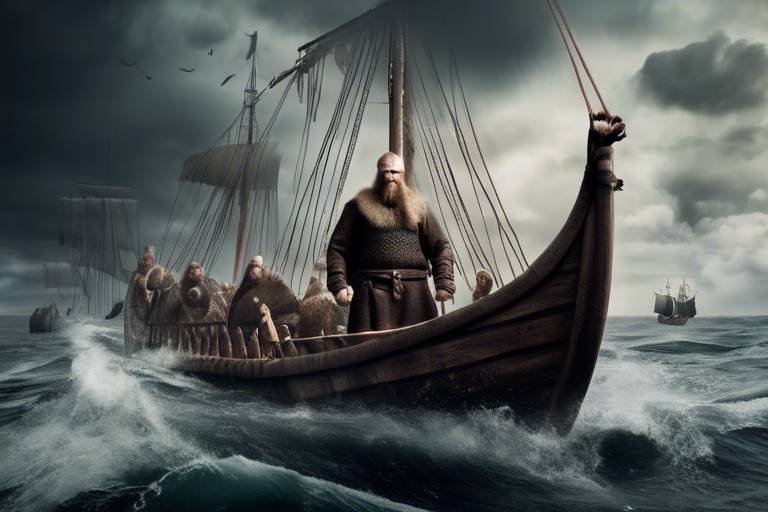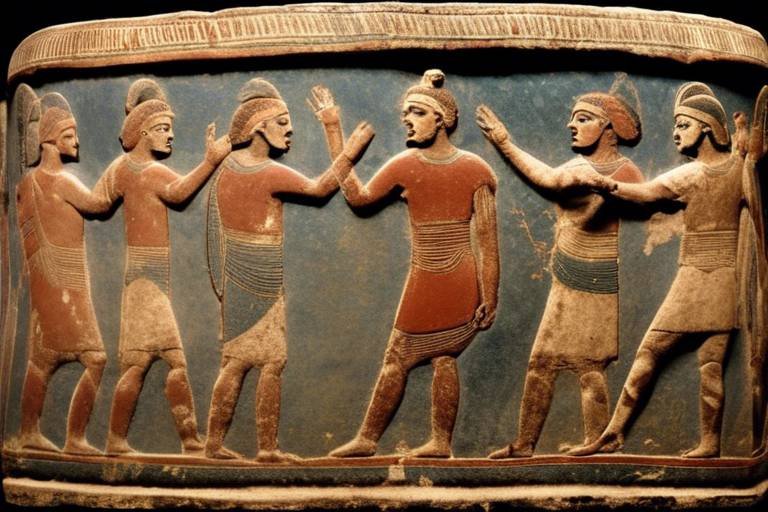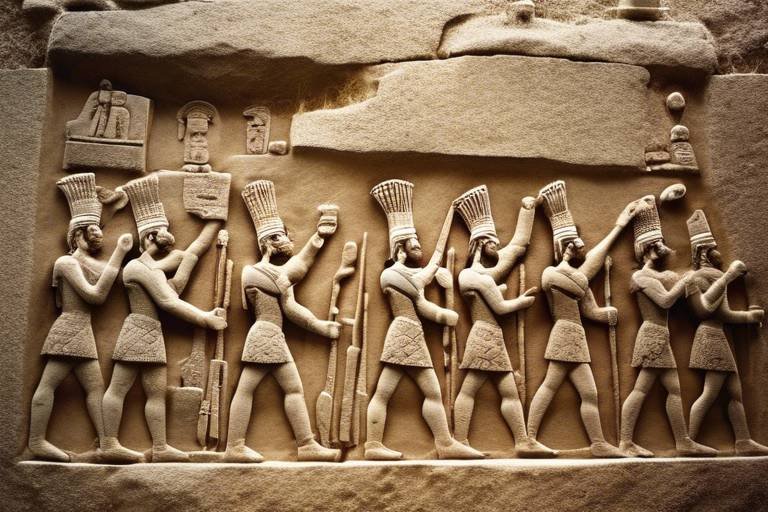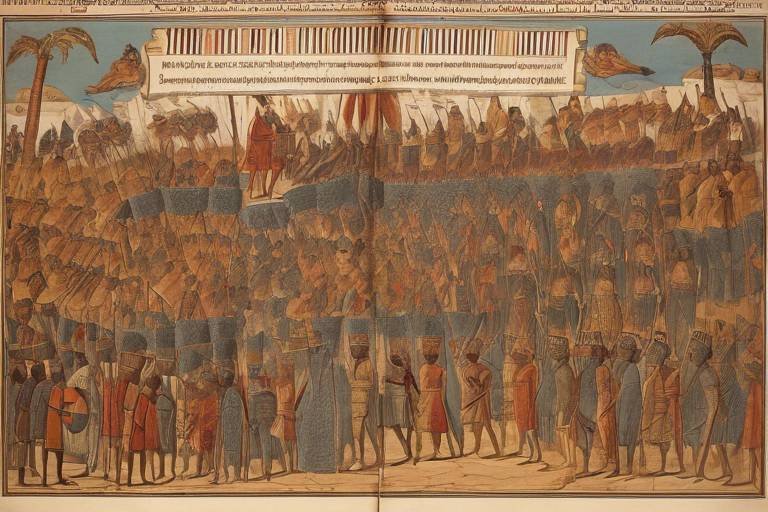The Influence of the Vikings on Maritime Trade
The Vikings, known for their fearless spirit and adventurous nature, played a significant role in shaping maritime trade during the medieval period. Through their exploration and conquests, they left a lasting impact on trade routes, navigation techniques, and cultural exchange across vast seas and distant lands.
One of the key elements that set the Vikings apart in maritime trade was their innovative ship designs. The longships, with their sleek and sturdy build, allowed them to navigate rough waters with ease and reach far-off destinations efficiently. These advanced vessels were crucial in expanding their trading networks and establishing connections with distant civilizations.
As the Vikings ventured out into the unknown waters, they established trade routes that spanned across Europe, Asia, and the Mediterranean. Their extensive networks not only facilitated the exchange of goods but also contributed to the flourishing global economy of the time. The Vikings' presence in various regions influenced local economies and fostered cultural interactions.
Moreover, the Vikings' advancements in navigation tools revolutionized maritime exploration. The use of instruments like the sun compass and astrolabe enabled them to navigate with precision, opening up new trade routes and opportunities for trade. Their expertise in navigation played a crucial role in expanding their influence across distant lands.
Through trade and interaction with different civilizations, the Vikings engaged in cultural exchange that transcended borders. This exchange of ideas, technologies, and goods not only enriched their own society but also influenced the development of other cultures. The Vikings' impact on cultural diffusion through trade remains a significant aspect of their legacy.
While the Vikings were renowned for their trading activities, raiding and plundering also played a significant role in their maritime trade ventures. These aggressive tactics, although controversial, shaped their relationships with other societies and contributed to their reputation as formidable seafarers. The dual nature of Viking trade, encompassing both peaceful exchange and violent raids, reflects the complexities of their maritime activities.
The legacy of Viking maritime trade practices continues to resonate in modern times, influencing contemporary shipping, navigation, and trade routes worldwide. The principles of efficiency, innovation, and adaptability that the Vikings exemplified in their trade endeavors have left a lasting imprint on the maritime industry, shaping its evolution over centuries.
Archaeological discoveries related to Viking maritime trade, including shipwrecks, trading posts, and artifacts, provide valuable insights into their commercial activities and seafaring lifestyle. These findings offer a glimpse into the material culture and economic significance of Viking trade, enriching our understanding of their maritime heritage.
Historical accounts, sagas, and folklore depict the prowess of the Vikings in maritime trade, highlighting their economic influence and seafaring achievements. These narratives capture the essence of Viking trade expeditions, showcasing their strategic vision, resourcefulness, and impact on the global trade landscape.

Viking Ship Designs
Exploring how the Vikings impacted the development of maritime trade routes, navigation techniques, and cultural exchange during the medieval period.
When delving into the realm of Viking maritime history, one cannot ignore the remarkable ship designs that played a pivotal role in their seafaring endeavors. The Vikings were known for their innovative approach to shipbuilding, crafting vessels that were not only sturdy but also highly efficient in navigating the unpredictable waters of the seas.
These ships were characterized by their sleek, long shapes and shallow drafts, allowing them to travel both deep into the open ocean and up rivers for raids and trade. The most famous of these vessels is the longship, or drakkar, which featured a symmetrical design with a single mast and square sail.
What set Viking ships apart were their flexibility and agility, enabling them to maneuver swiftly and navigate through narrow fjords and treacherous coastlines with ease. This design not only facilitated exploration but also provided an advantage in surprise attacks, a tactic the Vikings were renowned for.
Additionally, the use of clinker construction, where overlapping wooden planks were secured together, made the ships durable and seaworthy. This construction method allowed the vessels to withstand the harsh conditions of the North Atlantic and venture far beyond their homelands, reaching as far as North America.
The ingenious ship designs of the Vikings were a testament to their maritime expertise and played a crucial role in shaping their dominance in trade, exploration, and conquest during the medieval period.

Trade Routes and Networks
Trade Routes and Networks played a crucial role in the expansion of Viking influence across vast regions during the medieval period. The Vikings were skilled navigators and traders who established extensive trade networks connecting Europe, Asia, and the Mediterranean. These trade routes not only facilitated the exchange of goods but also served as conduits for the transmission of ideas, technologies, and cultural practices.
One of the most significant trade routes established by the Vikings was the Volga trade route, which connected Scandinavia to the Byzantine Empire via the river systems of Eastern Europe. This route enabled the Vikings to trade commodities such as furs, amber, and slaves for luxury goods like silk, spices, and silver. The wealth generated from these trade ventures fueled the Viking economy and contributed to their growing influence in the region.
Furthermore, the Vikings also utilized maritime trade routes to establish trading posts in key strategic locations. These trading posts served as hubs for commercial activities and cultural exchange, attracting merchants and travelers from distant lands. The presence of Viking trading posts in places like Dublin, Novgorod, and Constantinople solidified their position as prominent players in the global trade network of the time.
In addition to traditional trade routes, the Vikings also engaged in long-distance maritime expeditions to explore new territories and establish trade partnerships with foreign civilizations. Their mastery of navigation techniques, such as using the sun compass and reading the stars, allowed them to navigate the treacherous waters of the North Atlantic and reach as far as North America.
The interconnected nature of Viking trade routes and networks not only facilitated economic prosperity but also fostered cultural exchange and diplomatic relations with other societies. Through trade, the Vikings were able to forge alliances, establish trading agreements, and exchange knowledge with diverse cultures, leaving a lasting impact on the development of global trade networks.

Impact on Navigation
Exploring how the Vikings impacted the development of maritime trade routes, navigation techniques, and cultural exchange during the medieval period.
When we delve into the impact of the Vikings on navigation, we uncover a world of innovation and advancement that shaped the course of maritime exploration. The Vikings' mastery of navigation tools such as the sun compass and astrolabe propelled them to new horizons, enabling them to traverse vast oceans with confidence and precision. Imagine the awe-inspiring sight of a Viking longship cutting through the waves, guided by the stars above and the knowledge passed down through generations.
These advancements revolutionized the way sailors navigated the seas, opening up new trade routes and connecting distant lands in ways previously unimaginable. The Viking navigational techniques not only facilitated their own journeys but also laid the foundation for future explorers to follow in their wake, leaving a lasting legacy on the maritime world.
Through their expertise in navigation, the Vikings not only expanded their own reach but also contributed to the broader understanding of seafaring that would shape the course of history. Their impact on navigation was not just about reaching new lands but about forging connections that transcended borders and cultures, paving the way for a more interconnected world.

Cultural Exchange and Influence
When delving into the realm of Viking maritime trade, one cannot overlook the significant impact it had on cultural exchange and influence during the medieval period. Through their extensive trading ventures, the Vikings played a crucial role in fostering connections between various civilizations, leading to a rich exchange of ideas, technologies, and goods.
One of the key aspects of the Viking cultural exchange was the assimilation of diverse practices and beliefs from the regions they traversed. This amalgamation of different cultural elements not only enriched the Viking society but also contributed to the diffusion of knowledge and innovation across borders.
Moreover, the trade interactions of the Vikings with other societies facilitated the spread of commodities such as spices, textiles, and precious metals, which not only fueled economic growth but also enhanced the cultural diversity of the regions involved in the trade networks.
Through their trade routes spanning from Europe to Asia and the Mediterranean, the Vikings acted as conduits for the exchange of not just material goods but also intellectual and artistic endeavors. This cross-pollination of cultures left an indelible mark on the societies they encountered, shaping their customs, languages, and worldviews.
Furthermore, the cultural influence of the Vikings extended beyond tangible trade goods, as they also introduced new technologies and navigational techniques to the regions they traded with. The exchange of knowledge in areas such as shipbuilding, navigation, and agricultural practices contributed to the overall advancement of maritime civilizations.
In essence, the cultural exchange and influence brought about by Viking maritime trade were pivotal in bridging the gap between distant lands and fostering a sense of interconnectedness among diverse peoples. The legacy of this exchange continues to resonate in modern societies, underscoring the enduring impact of the Vikings on global cultural heritage.

Raiding and Plundering
When delving into the realm of Viking maritime trade, one cannot overlook the significant role of raiding and plundering in shaping their interactions with other societies. The Vikings were notorious for their daring raids along coastlines, targeting wealthy settlements and monasteries in search of valuable treasures. These aggressive tactics not only secured resources for the Viking communities but also instilled fear in their adversaries, establishing a reputation that preceded them wherever they ventured.
Through their raids, the Vikings not only acquired riches but also expanded their influence across distant lands, establishing trade networks that facilitated the exchange of goods and ideas. While raiding may seem like a purely destructive practice, it played a crucial role in the Viking economy, driving the flow of wealth and resources that fueled their maritime endeavors.
Moreover, the act of plundering was not just about material gain; it was a strategic maneuver employed to assert dominance and control over key trade routes. By targeting strategic locations and disrupting existing trade networks, the Vikings were able to carve out a formidable position in the competitive landscape of medieval commerce.
Despite its controversial nature, raiding and plundering were integral components of Viking maritime trade, shaping the dynamics of power and influence in the medieval world. While the Vikings' reputation as fierce warriors and ruthless plunderers may precede them, their impact on maritime trade cannot be understated, as it laid the foundation for the expansion of their cultural and economic influence.

Legacy in Modern Maritime Practices
When it comes to the legacy of the Vikings in modern maritime practices, their impact is undeniable. The innovative ship designs and navigation techniques developed by the Vikings have left a lasting impression on how we navigate the seas today. Their ability to traverse rough waters and explore distant lands efficiently paved the way for modern shipping technology and techniques.
One of the key contributions of the Vikings to modern maritime practices is their emphasis on efficient trade routes and networks. By establishing trade routes across Europe, Asia, and the Mediterranean, the Vikings played a crucial role in shaping the global economy of their time. This emphasis on trade and commerce laid the foundation for modern international trade practices and logistics.
Furthermore, the advancements made by the Vikings in navigation tools such as the sun compass and astrolabe have revolutionized maritime exploration. These tools, coupled with their navigational skills, set the stage for modern navigation systems used in shipping and trade routes around the world.
Moreover, the cultural exchange facilitated by Viking maritime trade has had a profound impact on modern societies. Through trade, the Vikings spread ideas, technologies, and goods, influencing the cultural landscape of regions they visited. This cultural exchange laid the groundwork for modern globalization and the interconnected nature of today's world.
While raiding and plundering were integral parts of Viking maritime trade, their legacy in modern practices focuses more on the positive aspects of their seafaring prowess. The lessons learned from Viking trade routes, navigation techniques, and cultural exchange continue to shape modern shipping, navigation, and trade practices, highlighting the enduring influence of the Vikings on the maritime world.

Archaeological Discoveries
Archaeological excavations have unearthed a treasure trove of artifacts and evidence shedding light on the extensive maritime trade conducted by the Vikings. Among the most notable discoveries are well-preserved Viking longships, showcasing the intricate craftsmanship and advanced design that enabled their navigation across treacherous waters. These ships, often found in burial sites or sunken wrecks, provide invaluable insights into the construction techniques and seafaring capabilities of the Vikings.
Furthermore, archaeological expeditions have revealed the existence of Viking trading posts in strategic locations along major waterways, serving as hubs for commercial activities and cultural exchange. These sites have yielded a wealth of imported goods from distant lands, indicating the extensive network of trade routes established by the Vikings. Additionally, artifacts such as coins, jewelry, and pottery unearthed at these sites offer tangible evidence of the economic prosperity and cross-cultural interactions facilitated by Viking maritime trade.
One remarkable discovery that captivated historians and archaeologists alike is the Oseberg ship, a remarkably well-preserved Viking vessel found in a burial mound in Norway. The intricately carved wooden ship, along with its rich array of grave goods, provides a glimpse into the opulence and craftsmanship associated with Viking seafaring culture. The Oseberg ship stands as a testament to the Vikings' maritime prowess and their reverence for the sea as a vital conduit for trade and exploration.
In addition to physical artifacts, archaeological investigations have uncovered remnants of Viking settlements and trading outposts in distant locales, underscoring the extensive reach of Viking maritime trade networks. These excavations have revealed the cultural assimilation and exchange that took place between the Vikings and indigenous populations, shaping the social fabric and material culture of various regions. Through the lens of archaeology, the legacy of Viking maritime trade continues to be unraveled, offering a glimpse into a dynamic and interconnected medieval world shaped by seafaring activities.

Historical Accounts and Sagas
When delving into the historical accounts and sagas of the Vikings, we uncover a treasure trove of stories that depict their remarkable seafaring prowess and economic influence. These accounts, passed down through generations, offer a glimpse into the adventurous spirit of the Vikings and their impact on maritime trade during the medieval period.
One of the most famous sagas that shed light on Viking maritime activities is the Saga of the Greenlanders, which narrates the journeys of Erik the Red and his son Leif Erikson to North America. Through these sagas, we learn about the Vikings' navigational skills, trade ventures, and encounters with new cultures, showcasing their role as early global traders.
Historical records also document the Viking raids and trading expeditions across Europe and beyond. The Anglo-Saxon Chronicle and Frankish Annals provide insights into the Viking incursions and their impact on the regions they visited. These accounts highlight the dual nature of Viking maritime activities, encompassing both trade and conflict.
Additionally, the Orkneyinga Saga offers a glimpse into the trading networks established by the Vikings in the North Atlantic region. It details the establishment of trading posts, such as the bustling port of Birka in present-day Sweden, which served as a hub for international trade and cultural exchange.
Furthermore, the Runic inscriptions found on artifacts and runestones provide valuable clues about Viking trade routes and commercial activities. These inscriptions, often carved in Old Norse, reveal the destinations visited by Viking traders, the goods exchanged, and the alliances forged with foreign merchants.
Through these historical accounts and sagas, we gain a deeper understanding of the Vikings' maritime trade practices and their enduring legacy in shaping the global economy of the medieval period. The tales of exploration, trade, and cultural exchange woven into these narratives continue to captivate historians and enthusiasts alike, painting a vivid picture of the Vikings' influence on maritime trade.
Frequently Asked Questions
- Q: What were some key Viking ship designs?
A: The Vikings were known for their innovative ship designs, such as the longship and the knarr. The longship was a versatile vessel used for both trade and warfare, featuring a shallow draft and a narrow hull for speed and maneuverability. The knarr, on the other hand, was specifically designed for carrying cargo over long distances, with a wider hull and more storage space.
- Q: How did Viking trade routes impact the global economy?
A: Viking trade routes spanned across Europe, Asia, and the Mediterranean, connecting distant regions and facilitating the exchange of goods, ideas, and technologies. This extensive network contributed to the growth of the global economy during the medieval period, allowing for the circulation of valuable commodities and cultural influences.
- Q: What tools did the Vikings use for navigation?
A: The Vikings utilized various navigation tools, including the sun compass and the astrolabe, to navigate the open seas. These instruments allowed them to determine their position relative to the sun and stars, enabling more accurate navigation and exploration of new trade routes and territories.
- Q: How did Viking raiding activities affect their maritime trade?
A: Raiding and plundering were integral aspects of Viking maritime trade, as they often used force to acquire goods and wealth from other societies. While this aggressive behavior created tensions with neighboring regions, it also allowed the Vikings to amass resources that further fueled their trading activities and influence in the region.
- Q: What is the legacy of Viking maritime trade in modern practices?
A: The legacy of Viking maritime trade can still be seen in modern shipping, navigation, and trade routes around the world. Their innovative ship designs and navigation techniques have influenced maritime practices to this day, shaping the way goods are transported and traded on a global scale.



















